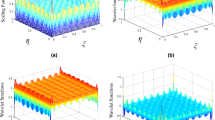Abstract
The wavelet scaling functions of spline wavelets are used to construct the displacement interpolation functions of triangular and rectangular thin plate elements. The displacement shape functions are then expressed by spline wavelet functions. A spline wavelet finite element formulation of thin plate bending is developed by using the virtual work principle. Two numerical examples have shown that the bending deflections and moments of thin plates agree well with those obtained by the differential equations and conventional elements. It is demonstrated that the current spline wavelet finite element method (FEM) can achieve a high numerical accuracy and converges fast. The proposed spline wavelet finite element formulation has a wide range of applicability since it is developed in the same way like conventional displacement-based FEM.




Similar content being viewed by others
References
Daubechies I (1992) Ten lectures on wavelets, CBMS–NSF regional conference series in applied mathematics. Department of Mathematics, University of Lowell, MA, Society for Industrial and Applied Mathematics, Philadelphia
Barker VA (2001) Some computational aspects of wavelets, informatics and mathematical modeling. Technical University of Denmark, Denmark
Chui CK (1992) An Introduction to Wavelet. Academic Press, New York
Burrus CS, Gopinath RA, Guo H (1998) Introduction to wavelets and wavelet transforms—a primer. Prentice-Hall, Upper Saddle River
Wei GW, Zhang DS, Althorpe SC, Kouri DJ, Hoffman DK (1998) Wavelet-distributed approximating functional method for solving the Navier-Stokes equation. Comput Phys Comm 115:18–24
Wells RO, Zhou X (1995) Wavelet solutions for the Dirichlet problem. Numer Math 70:379–396
Ma JX, Xue JJ, Yang SJ, He ZJ (2003) A study of the construction and application of a Daubechies wavelet-based beam element. Finite Elem Anal Des 39:956–975
Zhou YH, Wang JZ, Zheng XJ (1998) Application in beam and flat structure of wavelet Galerkin method. Appl Math Mech 19(8):697–705
Christon MA, Roach DW (2000) The numerical performance of wavelet for PDFs: the multi-scale finite element. Comput Mech 2000(25):230–244
Kaminski M (2005) Homogenization-based finite element analysis of unidirectional composites by classical and multiresolutional techniques. Comput Methods Appl Mech Eng 194(18–20):2147–2173
Han JG, Ren WX, Huang Y (2005) Multivariable wavelet based finite element method and its application to thick plates. Finite Elem Anal Des 41:821–833
Han JG, Ren WX, Huang Y (2006) A spline wavelet finite element method in structural mechanics. Int J Numer Methods Eng 66(1):166–190
Ayad R, Dhatt G, Batoz JL (1998) A new hybrid-mixed variational approach for Reissner-Mindlin plates: the MiSP model. Int J Numer Methods Eng 42:1149–1179
Kikuchi F, Ishii K (1999) An improved 4-node quadrilateral plate bending element of Reissner-Mindlin type. Comput Mech 23:240–249
Zienkiewicz OC, Taylor RL (1991) The finite element method, 4th edn, vol 2. McGraw-Hill, NY
Allman DJ (1988) A quadrilateral finite element including vertex rotation for plane elasticity analysis. Int J Numer Methods Eng 26:717–730
Melosh JR (1963) Basis for derivation of matrices for the direct stiffness method. AIAA J 1(7):1631–1637
The Mathworks, Inc. (1996) Matlab release 5, Natick, MA, USA
Timoshenko SP, Young DH (1965) Theory of structures. McGraw-Hill, NY
Timoshenko SP, Krieger SW (1959) Theory of plates and shells, 2nd edn. McGraw-Hill, NY
Acknowledgments
Support from the national Natural Science Foundation of China (NSFC), grant number 50668001, is greatly acknowledged. The second author also thanks the financial support from the Program for New Century Excellent Talents (NCET) in University, Ministry of Education, People’s Republic of China.
Author information
Authors and Affiliations
Corresponding author
Rights and permissions
About this article
Cite this article
Han, JG., Ren, WX. & Huang, Y. A spline wavelet finite element formulation of thin plate bending. Engineering with Computers 25, 319–326 (2009). https://doi.org/10.1007/s00366-009-0124-7
Received:
Accepted:
Published:
Issue Date:
DOI: https://doi.org/10.1007/s00366-009-0124-7



